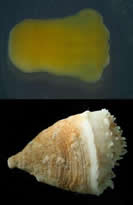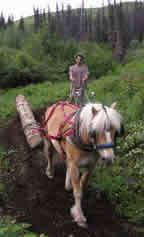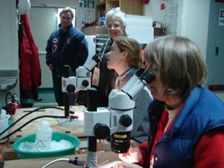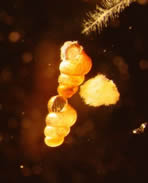
 |
| Academic Departments | Student Services | Alumni | Research | Outreach | Diversity |
| 1 | 2 | 3 | 4 | 5 | 6 | |
| 7 | 8 | 9 | 10 | 11 | 12 | 13 |
| 14 | 15 | 16 | 17 | 18 | 19 | 20 |
| 21 | 22 | 23 | 24 | 25 | 26 | 27 |
| 28 | 29 | 30 | 31 |
| 1 | 2 | 3 | ||||
| 4 | 5 | 6 | 7 | 8 | 9 | 10 |
| 11 | 12 | 13 | 14 | 15 | 16 | 17 |
| 18 | 19 | 20 | 21 | 22 | 23 | 24 |
| 25 | 26 | 27 | 28 | 29 | 30 |
Daily Journals
May 29, 2006 - We Cross the Antarctic Circle
We are heading southwest toward Station 31 in the Matha Strait. After that, we will travel along Adelaide Island into Marguerite Bay. If you are watching a chart of our travels, you will see that we crossed the Antarctic Circle in there somewhere, as we hit the Latitude of The Line. There was no fanfare, a few of us looked up from our books in the lounge to see the coordinates change on the Ship’s Monitor (has all of the information I put in the Journal heading each day), I took a photo of it just afterwards (sorry, that’s how anti-climactic this was), and then we went back to our reading. I understand the Equator and Arctic Circle have more ritual than that, but this was all very dignified. (The other two circles of latitude are the Tropic of Cancer and Tropic of Capricorn did you already know that?) (See photo at right) We have been steaming for a very long time now. There have been only 2 stops in the past 24 hours, and people are itching to be busy again, because there just is not that much more to do that’s comfortable to do on these rolling seas. Some work at their computers, others sleep or read. The labs are in pretty good shape as far as having samples labeled, logged, and taped shut for the part of the trip when they’re all put into the shipping boxes for offloading back in Punta Arenas. I had the opportunity to catch up with Rhian Waller’s coral operations (Journal #5). Rhian had previously seen the Antarctic corals only as preserved specimens, which she used for her PhD thesis. She knew from dissecting the preserved sample that this coral ‘broods’ that is to say, they develop babies inside their bodies rather than laying eggs, or ‘spawning’. The hope was that she could get a live coral to produce babies and then observe them to see how they developed at which point in time they ‘settled’ and started to form their calcium skeleton. She was able to capture a few Flabellum corals from the benthic hauls. From these, carefully housed in tupper-like boxes with chips of tiles lining the bottoms, some coral babies emerged from between the adult’s tentacles. At first, the larvae are soft orange- or yellow-colored disks, a little smaller than a lentil or split pea. They sit on the bottom of the ‘tank’ rather than float like some of the larvae we’re catching in nets. But Rhian is seeing that these larvae do ambulate or move around under their own power, ultimately (but not necessarily permanently) to find the right spot to attach and mature. Interestingly, they change shape or ‘morph’ several times during their development, sometimes possibly due to their surroundings or interactions with other larvae. Rhian provided the image here of a larva (photo by Rhian Waller) many times enlarged for the sake of detail, above a parental unit (photo by Susie Balser) You will see that the ‘baby’ will have to go through a lot of changes to become an ‘adult’. The ‘knobs’ at the rightside end of the larva will become tentacles like the white ones seen emerging from the parent. Very cool. Getting to Know You - LMG’s Marine Computer/Instrument Specialists (a.k.a. E.T.’s) Kevin Pedigo Dan Elsberg Don't hesitate to email questions to us at outreach@lmg.usap.gov
|
Longitude/Latitude: S66° 33.386’ W68°13.659 ’ Temperature: Wind: 33kn Wind Chill: -19.8°C
Menu: Oven baked pork spare ribs, stir fry chicken, brussels sprouts, mixed vegs, rice, salad; Hamburgers and hot dogs, chicken patty, carrots, green beans, rice, and cookies.
Photos:Ship’s monitor, on which navigational and environmental conditions are displayed.
Larval and adult of Flabellum sp.
Dan Elsberg and “Lily” moving logs to the cabin site in Alaska
Captain Marty Galster checks into the Plankton Lab. Who’s workin’, who’s not??? Microscope photo of snails from plankton tow sample. [Photo by Pam Polloni] |
- Alabama Agricultural Experiment Station
- Alabama Cooperative Extension System
- Auburn Online Community
- Bookstore
- Center for Diversity
- Crisis/Incident Assistance
- Diversity and Multicultural Affairs
- Financial Aid
- Hotel and Conference Center
- Jule Collins Smith Museum of Fine Art
- Medical Clinic
- Southeastern Raptor Center
- Special Reports
- Students w/ Disabilities
- Theatre



